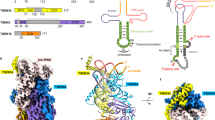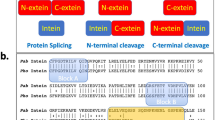Abstract
Homing endonucleases are a diverse collection of proteins that are encoded by genes with mobile, self-splicing introns1,2,3. They have also been identified in self-splicing inteins (protein introns)4. These enzymes promote the movement of the DNA sequences that encode them from one chromosome location to another; they do this by making a site-specific double-strand break at a target site in an allele that lacks the corresponding mobile intron3. The target sites recognized by these small endonucleases are generally long (14–44 base pairs). Four families of homing endonucleases have been identified, including the LAGLIDADG, the His–Cys box, the GIY–YIG and the H–N–H endonucleases1. The first identified His–Cys box homing endonuclease was I-PpoI from the slime mould Physarum polycephalum5,6. Its gene resides in one of only a few nuclear introns known to exhibit genetic mobility7. Here we report the structure of the I-PpoI homing endonuclease bound to homing-site DNA determined to 1.8 Å resolution. I-PpoI displays an elongated fold of dimensions 25 × 35 × 80 Å, with mixed α/β topology. Each I-PpoI monomer contains three antiparallel β-sheets flanked by two long α-helices and a long carboxy-terminal tail, and is stabilized by two bound zinc ions 15 Å apart. The enzyme possesses a new zinc-bound fold and endonuclease active site. The structure has been determined in both uncleaved substrate and cleaved product complexes.
This is a preview of subscription content, access via your institution
Access options
Subscribe to this journal
Receive 51 print issues and online access
$199.00 per year
only $3.90 per issue
Buy this article
- Purchase on Springer Link
- Instant access to full article PDF
Prices may be subject to local taxes which are calculated during checkout






Similar content being viewed by others
References
Belfort, M. & Roberts, R. Homing endonucleases — keeping the house in order. Nucleic Acids Res. 25, 3379–3388 (1997).
Belfort, M., Reaban, M. E., Coetzee, T. & Dalgaard, J. Z. Prokaryotic introns and inteins: a panoply of form and function. J. Bacteriol. 177, 3897–3903 (1995).
Belfort, M. & Perlman, P. S. Mechanisms of intron mobility. J. Biol. Chem. 270, 30237–30240 (1995).
Cooper, A. A. & Stevens, T. H. Protein splicing: self-splicing of genetically mobile elements at the protein level. Trends Biochem. Sci. 20, 351–356 (1995).
Ellison, E. L. & Vogt, V. M. Interaction of the intron-encoded mobility endonuclease I-PpoI with its target site. Mol. Cell. Biol. 13, 7531–7539 (1993).
Muscarella, D. E. & Vogt, V. M. Amobile group I intron in the nuclear rDNA of Physarum polycephalum. Cell 56, 443–454 (1989).
Johansen, S., Embley, T. M. & Willassen, N. P. Afamily of nuclear homing endonucleases. Nucleic Acids Res. 21, 4405 (1993).
Duan, X., Gimble, F. & Quiocho, F. Crystal structure of PI-SceI, a homing endonuclease with protein splicing activity. Cell 89, 555–564 (1997).
Heath, P. J., Stephens, K. M., Monnat, R. J. & Stoddard, B. L. The structure of I-CreI, a group I intron-encoded homing endonuclease. Nature Struct. Biol. 4, 468–476 (1997).
South, T. L., Blake, P. R., Hare, D. R. & Summers, M. F. C-terminal retroviral-type zinc finger domain from the HIV-1 nucleocapsid protein is structurally similar to the N-terminal zinc finger domain. Biochemistry 30, 6342–6349 (1991).
Luisi, B. F. et al. Crystallographic analysis of the interaction of the glucorticoid receptor with DNA. Nature 352, 497–505 (1991).
Marmorstein, R., Carey, M., Ptashne, M. & Harrison, S. C. DNA recognition by GAL4: structure of a protein–DNA complex. Nature 356, 408–414 (1992).
Everett, R. D. et al. Anovel arrangement of zinc-binding residues and secondary structure in the C3HC4 motif of an alpha herpes virus protein family. J. Mol. Biol. 234, 1038–1047 (1993).
Barlow, P. N., Luisi, B., Milner, A., Elliot, M. & Everett, R. Structure of the C3HC4domain by 1H-nuclear magnetic resonance spectroscopy. J. Mol. Biol. 237, 201–211 (1994).
Borden, K. L. B. et al. The solution structure of the RING finger domain from the acute promyelocytic leukaemia proto-oncoprotein PML. EMBO J. 14, 1532–1541 (1995).
Phillips, S. E. V. The β-ribbon DNA recognition motif. Ann. Rev. Biophys. Biomol. Struct. 23, 671–701 (1994).
Kim, J. L., Nikolov, D. B. & Burley, S. K. Co-crystal structure of TBP recognizing the minor groove of a TATA element. Nature 365, 520–527 (1993).
Kim, Y., Geiger, J. H., Hahn, S. & Sigler, P. B. Crystal structure of a yeast TBP–TATA-box complex. Nature 365, 512–520 (1993).
Schumacher, M. A., Choi, K. Y., Zalkin, H. & Brennan, R. G. Crystal structure of LacI member, PurR, bound to DNA: minor groove binding by α-helices. Science 266, 763–770 (1994).
Flick, K. E. et al. Crystallization and preliminary X-ray studies of I-PpoI: a nuclear, intron-encoded homing endonuclease from Physarum polycephalum. Protein Sci. 6, 1–4 (1997).
Otwinowski, Z. & Minor, W. Processing of X-ray diffraction data collected in oscillation mode. Methods Enzymol. 276, 307–326 (1997).
Leslie, A. G. W. in Joint CCP4 and ESF-EACMB Newsletter on Protein Crystallography (Daresbury Laboratory, Warrington, UK, 1992).
CCP4 The SERC (UK) Collaborative Computing Project No. 4, a Suite of Programs for Protein Crystallograph (Daresbury Laboratory, Warrington, UK, 1979).
QUANTA96 X-ray Structure Analysis User's Reference (Molecular Simulations, SanDieg, 1996).
Brünger, A. XPLOR version 3.1: A System for X-ray Crystallography and NMR (Yale Univ. Press, New Haven, CT, 1992).
Laskowski, R. J., Macarthur, M. W., Moss, D. S. & Thornton, J. M. PROCHECK: a program to check the stereochemical quality of protein structures. J. Appl. Crystallogr. 26, 383–290 (1993).
Evans, S. V. SETOR: hardware-lighted three-dimensional solid model representations of macromolecules. J. Mol. Graphics 11, 134–138 (1993).
Acknowledgements
We thank D. McHugh, K. Stephens and J. D. Heath for initial subcloning, purification and crystallization studies; R. Strong, K. Zhang and B. Scott for advice during the crystallographic analysis; and the beamline staff at the Advanced Light Source (NLBL laboratories), beamline 5.0.2, particularly T. Earnest, for assistance. B.L.S. and R.J.M. are funded for this project by the NIH. K.E.F. was supported by an NIH training grant and the American Heart Associaiton. M.S.J. was supported by an NSF fellowship and an NIH training grant.
Author information
Authors and Affiliations
Corresponding author
Rights and permissions
About this article
Cite this article
Flick, K., Jurica, M., Monnat, R. et al. DNA binding and cleavage by the nuclear intron-encoded homing endonuclease I-PpoI. Nature 394, 96–101 (1998). https://doi.org/10.1038/27952
Received:
Accepted:
Published:
Issue Date:
DOI: https://doi.org/10.1038/27952
This article is cited by
-
A unique eukaryotic lineage of composite-like DNA transposons encoding a DDD/E transposase and a His-Me finger homing endonuclease
Mobile DNA (2022)
-
Mobile group I introns at nuclear rDNA position L2066 harbor sense and antisense homing endonuclease genes intervened by spliceosomal introns
Mobile DNA (2022)
-
Introgression of a synthetic sex ratio distortion system from Anopheles gambiae into Anopheles arabiensis
Scientific Reports (2019)
-
Organochlorinated pesticides expedite the enzymatic degradation of DNA
Communications Biology (2019)
-
F-CphI represents a new homing endonuclease family using the Endo VII catalytic motif
Mobile DNA (2018)
Comments
By submitting a comment you agree to abide by our Terms and Community Guidelines. If you find something abusive or that does not comply with our terms or guidelines please flag it as inappropriate.



